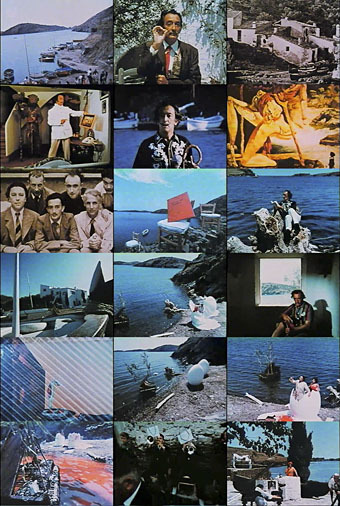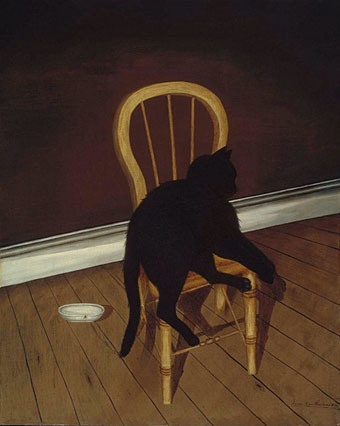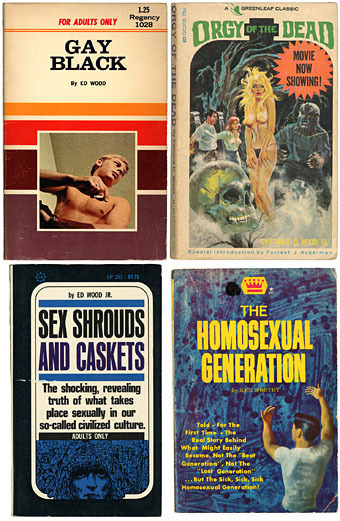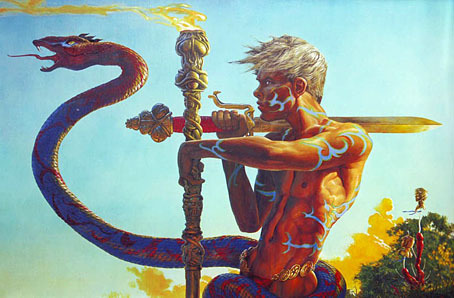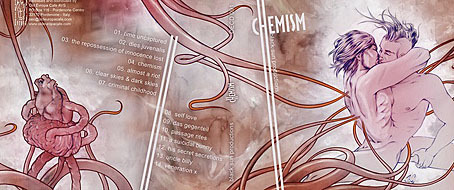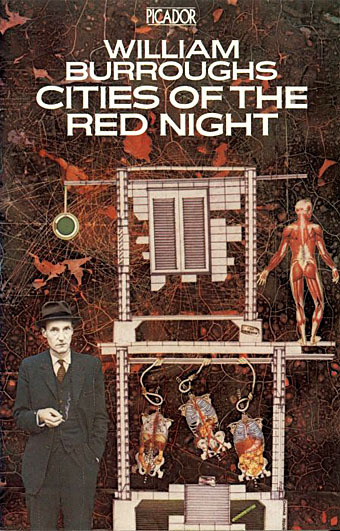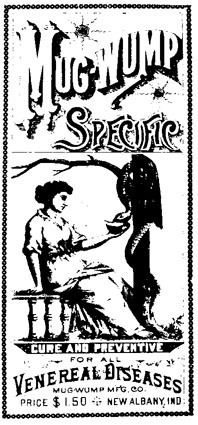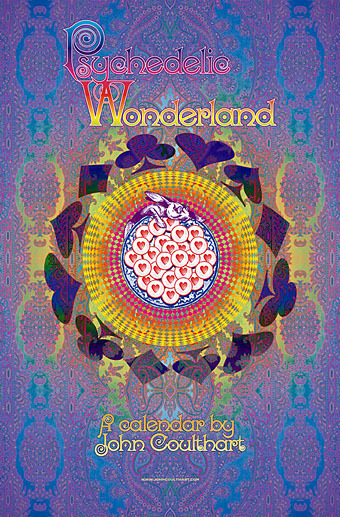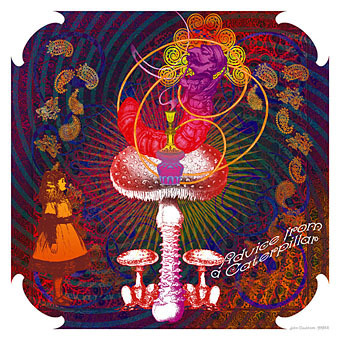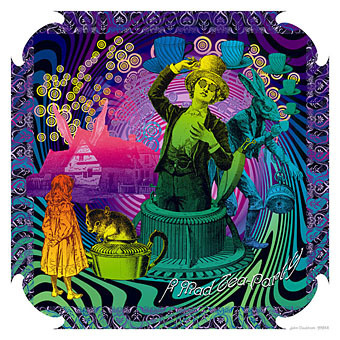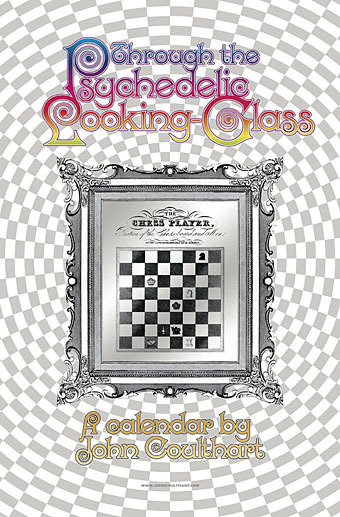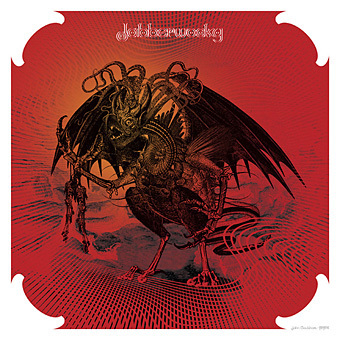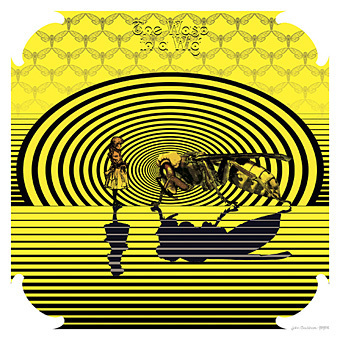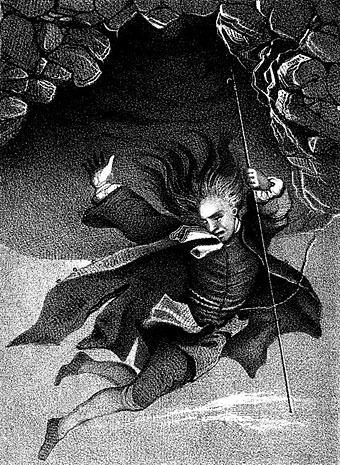John Coulthart's Blog, page 294
October 23, 2011
Soft Self-Portrait of Salvador Dalí
Yet another Dalí documentary, Soft Self-Portrait of Salvador Dalí is a welcome arrival at the splendid Ubuweb for its being the source of a number of sequences that turn up in later Dalí documentaries, notably the scenes of the artist and wife Gala emerging from giant eggs, and Dalí clattering away at a piano in which a number of unfortunate cats have been imprisoned. Jean-Christophe Averty is the director, and the narration for the English version is by Orson Welles. Ubuweb gives the date as 1967 but it's listed as 1970 on IMDB. Whatever the year, it's certainly the end of the 1960s with Dalí appearing a little more sprightly than in the Russell Harty film. He also appears wearing a shaggy wig out of sympathy for the youth of the day. (We know now that his sympathy for young men and women was more than a cultural interest.) Amid the usual boasting, tantrums and rather tiresome antics the filmmakers manage to come away with a couple of insights: at this point Gala was still appearing in public with Salvador, something she refused to do in later films. And there's a trip by boat to a rocky coastline which Welles' narration asserts was the inspiration for a number of the famous paintings. In all, it's 52 minutes of craziness that's recommended for anyone interested in Dalí's art.
See also: Photographer David McCabe's best shot in which that wig makes an appearance in the presence of another wig-wearing artist.
Previously on { feuilleton }
• Mongolian impressions
• Hello Dali!
• Dalí and the City
• Dalí's Elephant
• Dalí in Wonderland
• Alejandro Jodorowsky's Dune
• Dirty Dalí
• Impressions de la Haute Mongolie revisited
• Dalí and Film
• Salvador Dalí's apocalyptic happening
• Dalí Atomicus
• Impressions de la Haute Mongolie
October 22, 2011
Weekend links
Black Cat on a Chair (1850–1860) by Andrew L Von Wittkamp.
• "A little bit of acid, lots of weed, and too much Castaneda and I was ready to move from the magical realm of Middle Earth into a world that was much stranger than any involving hairy dwarves and white wizards…" Too Much to Dream by Peter Bebergal, "a psychedelic American boyhood".
This year's Booker prize isn't about the power of the new – there's no experiment with form or strangeness of imagination. The winner may get on the bedside tables of middle England, but that's not as important as changing the way that even one person dreams.
Jeanette Winterson throws the cat among the pigeons.
• 50 Watts continues to show us things you'd be hard-pressed to find elsewhere: illustrations by TagliaMani from a new edition of Les Chants de Maldoror, and War Is a Verb, collages by Allan Kausch.
• Don't go in the swimming pool! Coilhouse directs us to Fantasy: music by French outfit DyE with a weird and nasty animation by Jérémie Périn.
• Ace album cover designer and photographic Surrealist Storm Thorgerson is having another exhibition at IG Gallery, London.
• The Art of Leo and Diane Dillon, an art and illustration archive.
• John Turturro reads a short story by Italo Calvino.
• Spaceport America by Foster + Partners.
• Your Body of Work by Olafur Eliasson.
• Wonder-Cat cures all ailments.
• Krazy Kat (1927) by Frankie Trumbauer & His Orchestra with Bix and Lang | Pussy Cat Dues (1959) by Charles Mingus | Katzenmusik 5 (1979) by Michael Rother | Big Electric Cat (1982) by Adrian Belew | Purrfect (1996) by Funki Porcini.
October 21, 2011
Ed Wood's Sleaze Paperbacks
Yes, it's that , Mr Plan 9 from Outer Space, who apparently supplemented his erratic film career by penning dubious porn novels and exposés of the erotic underworld. Most of what I know about Ed Wood is culled from Tim Burton's biopic so this was news to me. Ed Wood's Sleaze Paperbacks is an exhibition at Boo-Hooray, New York, curated by Michael Daley and Johan Kugelberg:
The paperbacks are truly rare, even in an age of mass-searchable used book engines, and google ferocity. Ed Wood's sleaze fiction is also as strange, idiosyncratic and out of step with his times and mores as his infamous movies. Wood would write porn inter-spliced with lengthy philosophical, sociological and psychological discourse, he'd write first person narratives of life as a transvestite in the buttoned up America of the 1950's. He'd riff on psychosexual themes, and unleash his id, his ego and his superego in turn, sometimes in the same chapter. He'd write about sex and the human condition without veneer or filters, offering up the damaged and anguished voice of a desperately soul-searching drunk with a sense of self-worth that would stand in dichotomy to his self-pity.
Interesting to see Gay Black among the selected titles, a book I'd seen before in a Flickr collection of queer pulps. At the time I thought the credit must be coincidence, or some pseudonymous writer with a double-entendre name. The exhibition opens on November 2nd and runs to December 1st, 2011.
Elsewhere on { feuilleton }
• The book covers archive
October 20, 2011
John Holmes, 1935–2011
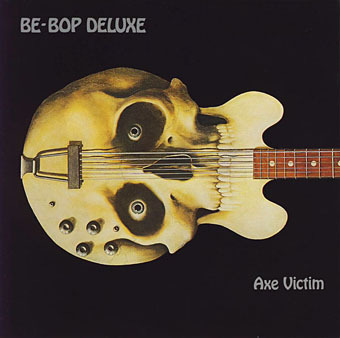
(1974).
Artist John Holmes, whose obituary was published this week, had a style that was immediately recognisable from the many paintings featured on book covers (and a few record sleeves) in the 1970s and 1980s. His painting for The Female Eunuch is by far the most well-known, of course, although I often used to wonder how many people who knew the picture could have named the artist responsible. Holmes' art brought a touch of Magritte-like Surrealism to cover illustration (at times the debt to Magritte was quite overt), and his images are familiar to anyone in the UK who was reading science fiction or horror during the 70s. He also has the distinction of being the first artist to provide a cover for an M. John Harrison book with the painting for Harrison's debut novel, The Committed Men, in 1971.
The McNeill Gallery has some original work for sale while the artist himself talked about some of his cover art at All Things Horror.
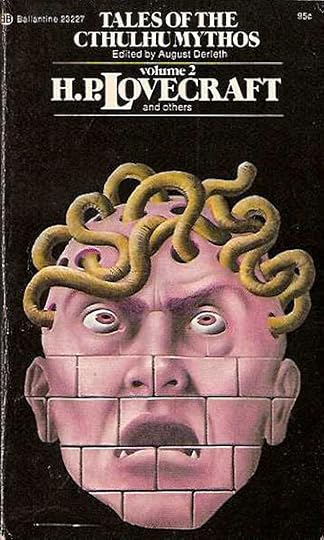
(1974).
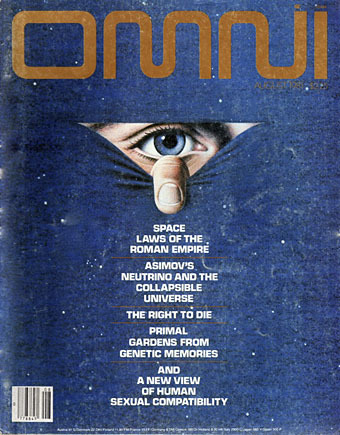
(1981).
Elsewhere on { feuilleton }
• The book covers archive
October 19, 2011
Looking for the Wild Boys
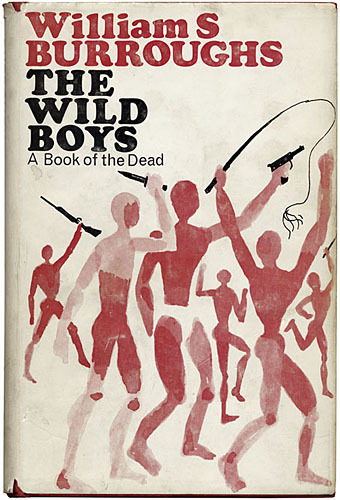
Calder & Boyars, 1972. Design by John Sewell.
This must be the first space novel, the first serious piece of science fiction—the others are entertainment.
Mary McCarthy defending The Naked Lunch in the New York Review of Books, June, 1963.
McCarthy's view—echoed a year later by Michael Moorcock and JG Ballard in the pages of New Worlds magazine—has never been popular or even particularly acceptable. William Burroughs gets touted as an sf writer by other writers, and John Clute gives him an entry in the Encyclopedia of Science Fiction, but Burroughs' sf scenarios are guaranteed to offend those readers who prefer their narratives presented in a neat, linear form with detailed explanations of How The Future Would Actually Work, or the physics behind some piece of imaginary technology. The books which immediately follow The Naked Lunch—The Soft Machine, The Ticket that Exploded, and Nova Express—all feature sf scenes or ideas. The latter was deemed sufficiently generic to prompt Panther Books in the UK to publish it three times as "Panther Science Fiction" although given the severe criticism that Moorcock sustained for trying to broaden the horizons of readers in the late 60s I don't expect sales were encouraging.
The Wild Boys, published in 1971 (1972 in the UK), was Burroughs' first novel after Nova Express, and his first book of fresh material after mining the stack of writing that birthed The Naked Lunch and the titles which followed. The novel is subtitled A Book of the Dead (as in the Egyptian or Tibetan Books of the Dead), and is certainly science fiction although I've never seen it marketed as such or noticed any sf reader include it in a list of notable genre novels of the period. My Calder & Boyers hardback offers a précis of the fractured narrative:
The year is 1988. The Wild Boys, adolescent guerilla armies of specialized humanoids, are destroying the armies of the civilized nations and ravaging the earth. The wild boys, who began in the pre-present past as petrol gangs, dousing their victims with petrol and setting them on fire for kicks, have grown to an army, dedicated to violence. One of them is used in a cigarette commercial. He becomes a new cult figure, a demi-god responsible for great destruction, and it is left to strong man Arachnid Ben Driss to exterminate the wild boys. He slaughters them, but the battle continues underground until all civilization collapses, revealing a future of horrifying dimensions. The originality of the theme and the very special Burroughs style together make this one of the most unusual science fiction novels ever, a prophetic exploration of the future, that should quickly establish itself as one of the classics of the present time.
That's accurate, up to a point, although like many book blurbs it misrepresents the content somewhat. It also neglects to say how funny the book is. For anyone with a black sense of humour Burroughs has always been a great comic writer, and The Wild Boys has some prime examples, not least the opening chapter, Tío Mate Smiles, which is best appreciated in the author's own reading.
Having gone through the novel in the past week, and going through its follow-up/appendix/remix Port of Saints at the moment, a couple of things occurred to me. The first was the way The Wild Boys strongly prefigures later works like Cities of the Red Night and The Place of Dead Roads. This is a fairly obvious point but it's one that hadn't fully clicked until now. The Wild Boys takes the problems of repressive control systems posed in the first few novels and offers a possible solution: a homoerotic utopia/dystopia where gangs of teenage boys hide out in depopulated regions, waging war against the rest of humanity with sex, magic and a mastery of weapons, including biological and viral varieties. While doing this they are steadily mutating so they can leave behind all human concerns with nation, family, laws and written language. Cities of the Red Night was Burroughs first novel after The Wild Boys and presents a less radical proposal, ranging through time with its anarchist pirate colonies and the six cities of the title. In The Place of Dead Roads Kim Carsons has his band of outlaw cowboys, The Wild Fruits, and the book gives us the conflict between the Johnsons—those who "mind their own business"—and the Shits: lawmen, politicians, tycoons, all the usual agents of Control.
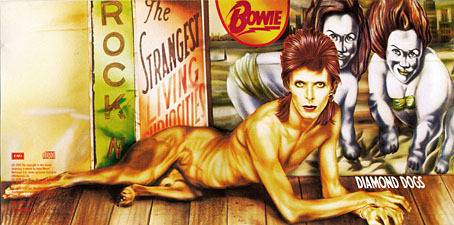
Diamond Dogs (1974). Painting by Guy Peellaert.
The more notable point about The Wild Boys is how influential the book has been. Something about the central idea captures the imagination of readers in a manner which exceeds the influence of Burroughs' other novels even though it's never been regarded as one of his best works. I noted an early possible example recently with a link to Burroughs' David Bowie interview from February 1974. Bowie had just finished recording his own dystopian concept album, Diamond Dogs, but at the time of the discussion seems to have only read Nova Express. Years later, however, we find this comment about the way the "Diamond Dogs" of his album prefigured London's punks:
…in my mind, there was no means of transport, so they were all rolling around on these roller-skates with huge wheels on them, and they squeaked because they hadn't been oiled properly. So there were these gangs of squeaking, roller-skating, vicious hoods, with Bowie knives and furs on, and they were all skinny because they hadn't eaten enough, and they all had funny-coloured hair. In a way it was a precursor to the punk thing.
Roller-skates, eh?
At a long work bench in the skating rink boys tinker with tiny jet engines for their skates. They forge and grind eighteen-inch bowie knives bolting on handles of ebony and ironwoods of South America that must be worked with metal tools…
The roller-skate boys swerve down a wide palm-lined avenue into a screaming blizzard of machine-gun bullets, sun glinting on their knives and helmets, lips parted eyes blazing. They slice through a patrol snatching guns in the air.
The Wild Boys, chapter 15.
No need to give Bowie grief over this, he introduced Burroughs to a wider audience than many who followed. The first mention of Burroughs' name that I recall was in the BBC Bowie documentary, Cracked Actor, also from 1974, with its scene of Bowie demonstrating his own version of the cut-up technique.
The Wild Boys would have been an ideal influence for punks but they were too damned queer for the most part so bands named themselves after junkier works like Dead Fingers Talk. John Foxx of Ultravox has mentioned The Wild Boys as an influence, and the first Ultravox album owes much to Diamond Dogs-era Bowie, but there's nothing specific in the lyrics beyond a general atmosphere of ambisexual weirdness and urban unease.
The next significant influence is also the most frustrating, a short film by Bruce Geduldig and Winston Tong from the mid-70s. Tong's pre-music career as a performance artist included a piece entitled Wild Boys but since information is scant about that and the film there's no way of knowing whether they're connected. Tong became a member of Tuxedmoon in the late 70s, with Geduldig also joining on to produce films for their shows. The Wild Boys soundtrack appeared on a rare Tuxedomoon release Joeboy In Rotterdam/Joeboy In San Francisco in 1981 (there's also a sample on this Biosphere track), and can now be found on a Tong solo CD, Like The Others, but the film remains elusive. If anyone has a copy, put it on YouTube, please!
(At this point I can imagine complaints if I don't mention Duran Duran. Very well. In the 1980s used to watch their Wild Boys video seized by a smouldering hatred, wishing fervently that the real Wild Boys would ride into the studio on their skates and chop the band into bloody chunks. Okay? No, I never liked them.)
For a visual interpretation we need to look to artist Oliver Frey who had a career in the 1980s producing erotic illustrations and comic strips for gay mags under the name Zack. Given the combination of Frey/Zack's considerable draughtsmanship and his flair for homoerotic depictions it's a shame he hasn't produced more work in this line. Burroughs' books still don't receive as much attention from gay artists as you might imagine.
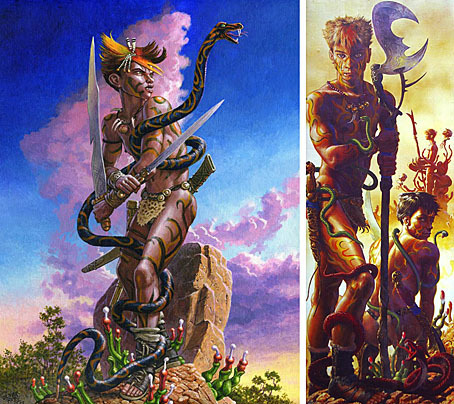
Frey's paintings date from the 1990s, and that's where many influences that had been percolating since the 1960s start to pick up speed. Among recent Wild Boys-derived works there's a musical piece by composer Colin Bright that mixes samples of Burroughs' voice with percussion and saxophone. Then there's art and magic from Elijah Burgher about whose Wild Boys 2 project he says:
WILD BOYS 2: Chapter O: An Aspiring Initiate's Letter of Application to Know Mysteries" is part of an ongoing project, WILD BOYS 2, that I intend as a sequel to William S. Burroughs' queer utopian novel, The Wild Boys, continuing, interpreting and critiquing some of the author's themes and images. WILD BOYS 2 is about queer desire, magic, masculinity, fraternity, wilderness, violence, catharsis, and the creation/destruction of self.
Chaos Magician Phil Hine also traced the magical theme in 2000 with an essay entitled Zimbu Xototl Time which examines the Wild Boys' occult techniques and attitudes:
Burrough's description of the wild boys' uninhibited sexuality is also interesting. Their sexuality is devoid of sentimentality & meaning; unhindered by either emotional values or a sense of transcendence.
Zimbu Xolotl Time is the wild boy festival where the different tribes gather to meet, exchange fighting techniques and indulge in communal orgies whereby zimbus* are created. The festival has no fixed date or place – the boys converge there instinctively:
"not know for sure until two weeks before time all boy stop fuck jack off he get there hot like fire." Port of Saints.
Chemism (2007) by Black Sun Productions. Design and illustration by Studio Dronio.
Black Sun Productions' Chemism album celebrates the queer/occult trend with an album dedicated to Burroughs that's also inspired by the novel. The title, we're told, refers to "mutual attraction, interpenetration, and neutralisation of independent individuals which unite to form a whole."
There are no doubt other inspirations that I've missed so if anyone knows of any, please leave a comment. The Wild Boys, like Burroughs' other idealist scenarios, is a separatist utopia, a wholly masculine world where women are no longer required. Despite this, Kathy Acker said it was her favourite Burroughs novel, and in 1996 she wrote about using it as a means to think about Wild Girls. Mary McCarthy opened this post so we'll let the last words go to Kathy:
…I see girls everywhere, girls being sexual, girls doing all and more than the boys I saw did when I used to sneak in my 20s down to the New York City wharves and hide there, in those shadows, when curling into one of the back corners of CBGBs, I would watch the endlessly skinny and black-clad legs of boys stride across a stage that was separated from me far more by gender than by space. Maybe I'm being perverse, but above all, I'm romantic and reading The Wild Boys makes me sing louder than Marianne Faithfull: "Give me more more more more…"
* Wild Boys can regenerate their dead by calling down male spirit forms which they incorporate by fucking until the spirit grows flesh. The newly formed creatures are called Zimbus.
Previously on { feuilleton }
• Wroblewski covers Burroughs
• Mugwump jism
• Brion Gysin's walk, 1966
• Burroughs in Paris
• William Burroughs interviews
• Soft machines
• Burroughs The Movie
• William S Burroughs: A Man Within
• The art of Oliver Frey
• The Final Academy
• William Burroughs book covers
• Towers Open Fire
October 18, 2011
Wroblewski covers Burroughs
Picador, 1982.
Being an occasional cover designer I naturally have a more than passing interest in how the books of favourite writers are packaged. I've mentioned a couple of times how much I liked the covers that Thomi Wroblewski produced in the 1980s for UK editions published by Picador and John Calder. Wroblewski is a designer who also creates his own artwork using a variety of media, with some form of collage being a common technique. Burroughs has had a number of decent designs over the years but Wroblewski is one of the few people loosed on his books who seemed to fully appreciate the tenor of the writing, and was able to convey something essential without ever being too abstract or too illustrative. I'd have been happy to see him design a complete range of the titles.
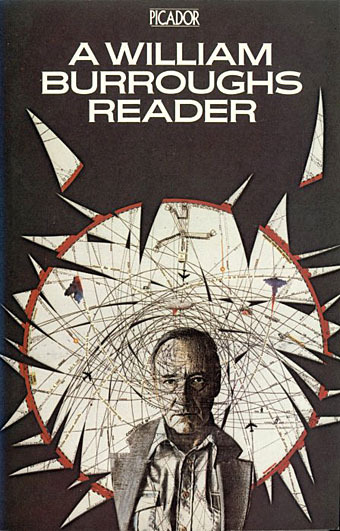
Picador, 1982.
Most of the covers here have been swiped from the excellent Burroughs page at Beat Book Covers where you can judge Wroblewski's work against other editions. An exception below is the art for an unknown edition of The Wild Boys, a picture described as being from 1988 so it may have been on a Picador cover I've never seen. The only cover at Beat Book Covers using that art is a later Russian edition. If anyone can say when and where Wroblewski's picture was first used, please leave a comment.
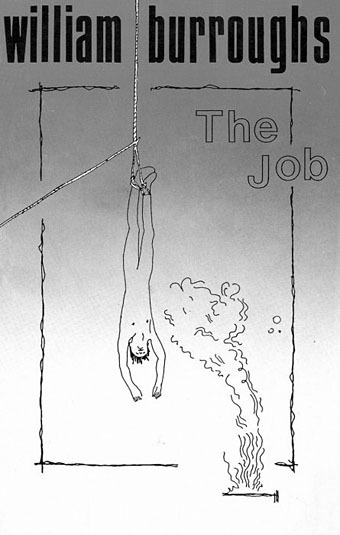
Calder, 1984.
Also below is an album cover from Wroblewski's parallel career as a music designer. Minutes was an audio magazine released in 1987 on the LTM label, and is included here since two of the tracks were Burroughs readings. The album has never been reissued but a copy from the vinyl can be downloaded here. Worthwhile mainly for WSB and Winston Tong of Tuxedomoon.
For more about the elusive Thomi Wroblewski, Momus wrote something about him a couple of years ago. There'll be more about The Wild Boys, and Winston Tong, tomorrow.
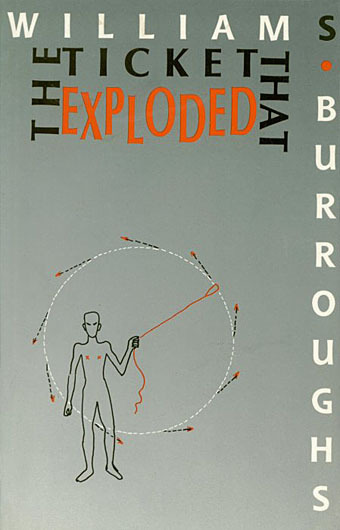
Calder, 1985.
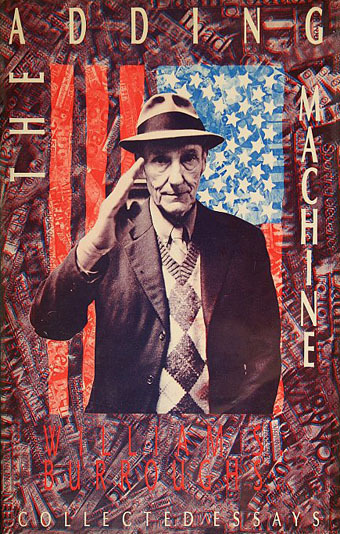
Calder, 1985.
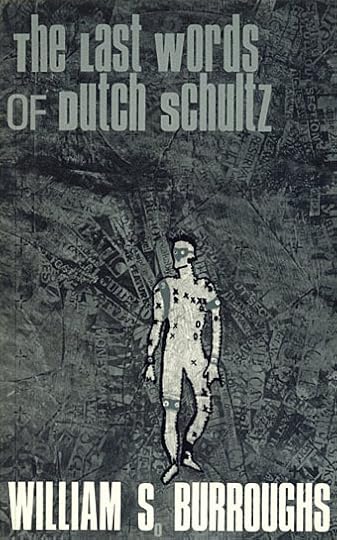
Calder, 1986.
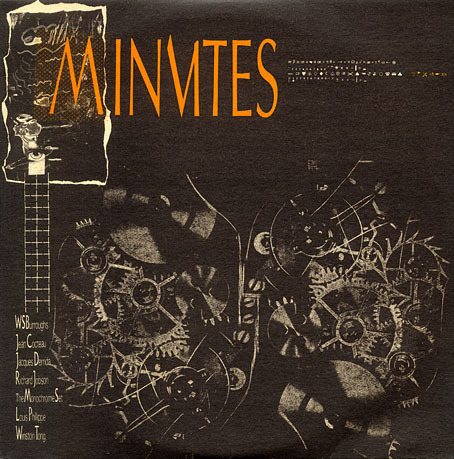
Minutes, 1987.
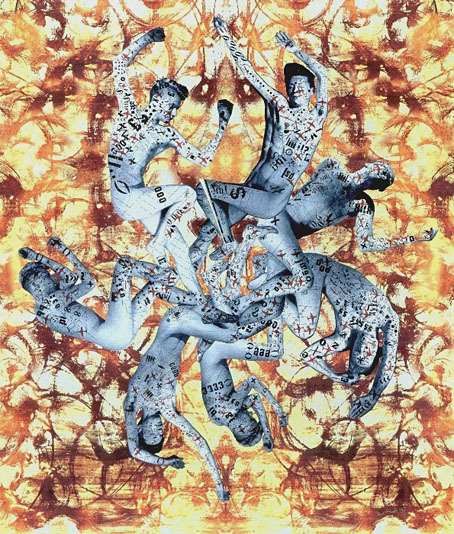
Art for The Wild Boys, 1988.
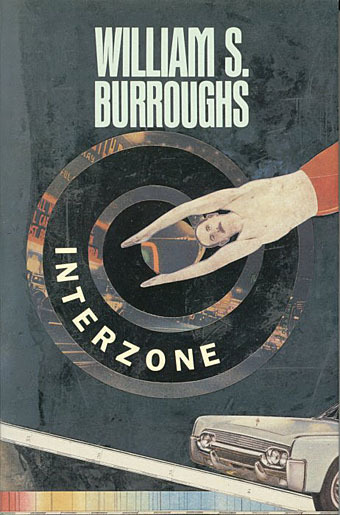
Picador, 1989.
Elsewhere on { feuilleton }
• The book covers archive
Previously on { feuilleton }
• Mugwump jism
• Brion Gysin's walk, 1966
• Burroughs in Paris
• William Burroughs interviews
• Soft machines
• Burroughs The Movie
• William S Burroughs: A Man Within
• The Final Academy
• William Burroughs book covers
• Towers Open Fire
October 17, 2011
Mugwump jism
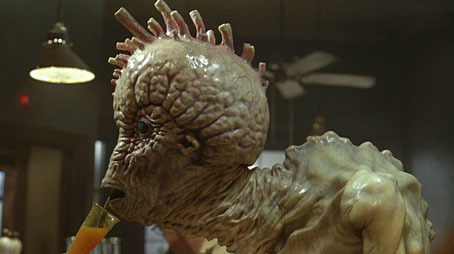
Naked Lunch (1991).
So what happens when you take a regular scenario like this:
There is a type person occasionally seen in these neighbourhoods who has connections with junk, though he is neither a user nor a seller. But when you see him the dowser wand twitches. Junk is close. His place of origin is the Near East, probably Egypt. He has a large straight nose. His lips are thin and purple-blue. The skin is tight and smooth over his face. He is basically obscene beyond any possible vile act or practice. He has the mark of a certain trade or occupation that no longer exists. If junk were gone from the earth, there might still be junkies standing around in junk neighbourhoods feeling the lack, vague and persistent, a pale ghost of junk sickness.
So this man walks around in the places where he once exercised his obsolete and unthinkable trade. But he is unperturbed. His eyes are black with an insect's unseeing cairn. He looks as if he nourished himself on honey and Levantine syrups that he sucks up through a proboscis.
What is his lost trade? Definitely of a servant class and something to do with the dead, though he is not an embalmer. Perhaps he stores something in his body—a substance to prolong life of which he is periodically milked by his masters. He is as specialized as an insect, for the performance of some inconceivably vile function.
Junkie (1953) by William Burroughs.
…and subject it to a dose of The Weird? This happens:
The Meet Café occupies one side of the Plaza, a maze of kitchens, restaurants, sleeping cubicles, perilous iron balconies and basements opening into the underground baths.
On stools covered in white satin sit naked Mugwumps sucking translucent, coloured syrups through alabaster straws. Mugwumps have no liver and nourish themselves exclusively on sweets. Thin, purple-blue lips cover a razor-sharp beak of black bone with which they frequently tear each other to shreds in fights over clients. These creatures secrete an addicting fluid from their erect penises which prolongs life by slowing metabolism. (In fact all longevity agents have proved addicting in exact ratio to their effectiveness in prolonging life.) Addicts of Mugwump fluid are known as Reptiles. A number of these flow over chairs with their flexible bones and black-pink flesh. A fan of green cartilage covered with hollow, erectile hairs through which the Reptiles absorb the fluid sprouts from behind each ear. The fans, which move from time to time touched by invisible currents, serve also some form of communication known only to Reptiles.
The Naked Lunch (1959) by William Burroughs.
Mugwump jism…The Weird…whatever you call it, I'm an addict. And while we're on the subject, this turned up at Wikimedia Commons in their Patent medicine section:
Mug-wump Manufacturing Co. for all Venereal Diseases…and you thought Burroughs was writing fiction?
Lastly, Justin Warfield and Tim Simenon have a message for ya. Play loud.
Previously on { feuilleton }
• Brion Gysin's walk, 1966
• Burroughs in Paris
• William Burroughs interviews
• Soft machines
• Burroughs The Movie
• William S Burroughs: A Man Within
• The Final Academy
• William Burroughs book covers
• Towers Open Fire
October 16, 2011
Coulthart calendars for 2012
I did have vague plans earlier this year for doing a new calendar but when work gets as busy as it has been you really need to plan these things weeks in advance and in the end I didn't have the time. Since I created my psychedelic Alice in Wonderland calendar in 2009 I've had a number of requests to make it available again. It's still the most popular thing I've sold at CafePress so this year I decided to reissue it along with last year's equally psychedelic take on Through the Looking-Glass. Here they are:
• Psychedelic Wonderland wall calendar at CafePress | A full preview of the pages
• Psychedelic Looking-Glass wall calendar at CafePress | A full preview of the pages
Advice from a Caterpillar.
A Mad Tea-Party.
Jabberwocky.
The Wasp in a Wig.
Previously on { feuilleton }
• Scenes from a carriage
• Through the Psychedelic Looking-Glass: the 2011 calendar
• Jabberwocky
• Alice in Acidland
• Return to Wonderland
• Dalí in Wonderland
• Virtual Alice
• Psychedelic Wonderland: the 2010 calendar
• Charles Robinson's Alice's Adventures in Wonderland
• Humpty Dumpty variations
• Alice in Wonderland by Jonathan Miller
• The Illustrators of Alice
October 15, 2011
Weekend links
Niels Klim's descent to the planet Nazar from the 1845 edition of Nicolai Klimii Iter Subterraneum (Niels Klim's Underground Travels) (1741) by Ludvig Holberg.
BibliOdyssey posts illustrations from different editions of Ludvig Holberg's satirical fantasy, appends the usual informative links and draws our attention Stories of a Hollow Earth at The Public Domain Review. I'd not come across the latter site before but it's now bookmarked.
• While the economy of Europe continues to circle the toilet bowl it's good to know that our Prime Minister is focusing on the important issues such as…limiting access to internet pornography. "Look at the implementation, and no matter where you stand on porn, I think you'll see this plan is going to cause a lot of problems on its way to the eventual fail bin," says Violet Blue. I was wondering how the four targeted ISPs would feel about a filtering plan that would drive many new customers elsewhere. The Register reports their response which comes down to offering guidelines rather than attempting the difficult and contentious task of filtering millions of websites.
• Related: Won't you fuck off, Reg Bailey, in which the report by the small Christian pressure group that started all the fuss is eviscerated. | Elsewhere: Porn is good for society says Anna Arrowsmith, while Tristan Taormino asserts that "writing and publishing erotica, especially for minorities, is a political act." Then there's Pornsaints, "an artistic approach to porn, a pornographic approach to art, a pornartistic approach to religion."
• In the music world: Richard H Kirk and Peter Care discuss Cabaret Voltaire and Johnny YesNo, Roy Harper talks to Alex Petridis, and soundtrack composer Cliff Martinez is interviewed (and pictured playing a Cristal).
• Witch's Cradle at Strange Flowers (Maya Deren, Marcel Duchamp and Peggy Guggenheim), The Ghosts of Senate House, London, and Aleister Crowley's Abbey of Thelema as it is today.
• RIP Frank Kameny, co-founder of the Mattachine Society, and a tireless gay rights advocate from the early 1960s on.
• Bruce Weber photographs some of the dancers from Matthew Bourne's Dance Company.
• Terry Gilliam says "I used to think I could will things into existence. Not any more."
• Five From…: assorted wit and wisdom in the Tumblr labyrinth.
• Glass art by Jasmine Targett.
• Porno Base (1982) by 23 Skidoo | Kylie Minogue (2003) by Satanicpornocultshop | Tantric Porno (live) (2009) by Bardo Pond.
October 14, 2011
The art of Jacopo Ligozzi, 1547–1627
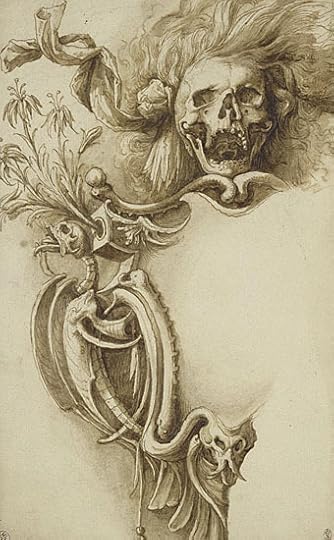
Cartouche with Macabre Symbols and a Hairy Skull (no date).
Some macabre things for a macabre month. Jacopo Ligozzi was a Mannerist artist, and the date of his birth here is the most commonly cited one, some sources give later years. The excesses of Mannerism—distorted figures, sensational subject matter, grotesquery in general—used to be regarded with suspicion if not downright hostility by the guardians of good taste who write art history books. Peter & Linda Murray's frequently snotty Dictionary of Art and Artists (1959) describes the style as being "best adapted to neurotic artists", then goes on to list a few allegedly neurotic types, none of whom are Ligozzi. Judging by these examples, the artist had a thing for memento mori since many of the examples of his work online are grotesque cartouches or scenes of a rampaging Death. The last picture here showing a curious peacock boat is credited to Remigio Cantagallina and was discovered at the rather wonderful Frequent Peacock (now relocated here), another site which saves me the trouble of searching out further peacock pictures.
Thanks to Wunderkammer for the Ligozzi tip!
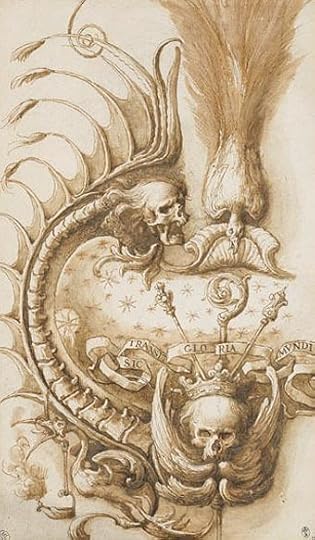
Cartouche with Macabre Symbols (no date).
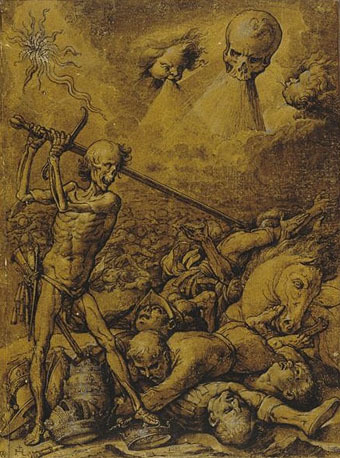
Death Exterminating Mankind (1625).
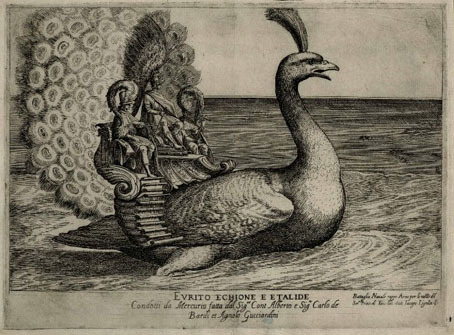
Remigio Cantagallina after Jacopo Ligozzi (1608).
Previously on { feuilleton }
• Massachusetts memento mori
• Skull cameras
• Walmor Corrêa's Memento Mori
• The skull beneath the skin
• Vanitas paintings
• Very Hungry God
• History of the skull as symbol
John Coulthart's Blog
- John Coulthart's profile
- 31 followers


